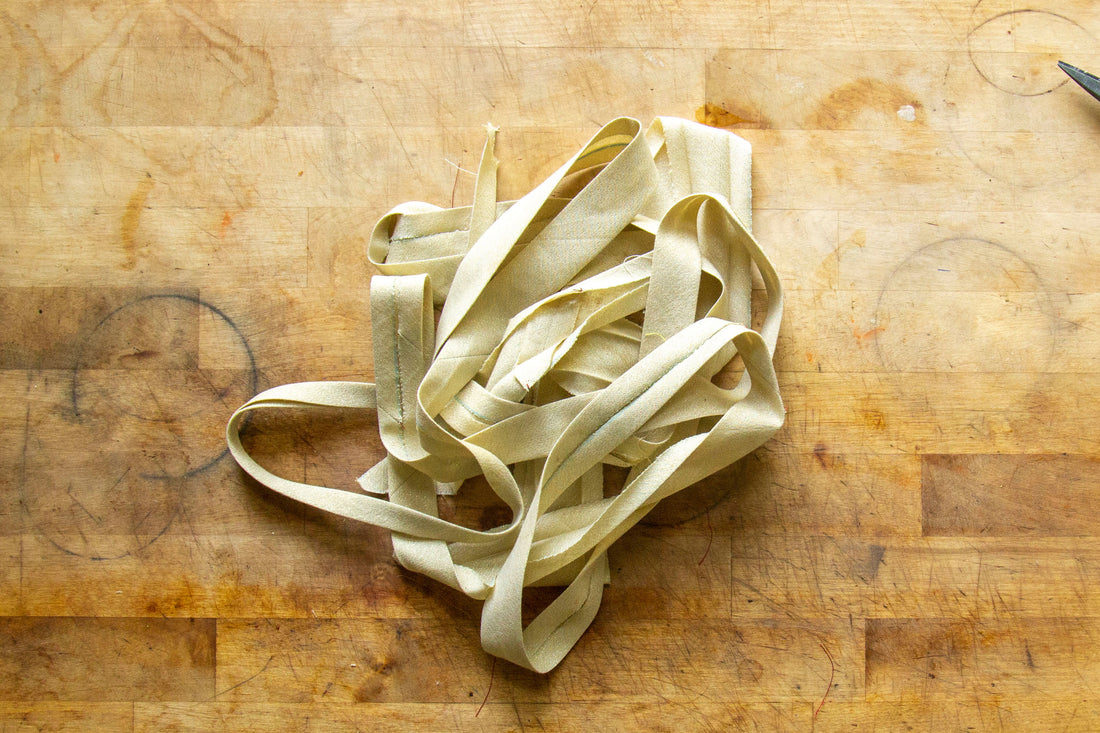I have always really enjoyed making bias binding. I know that many may view it as a somewhat tedious task, but there is something about it'd tediousness that I find rather soothing. It's like doing anything somewhat repetitive- you get into a rhythm and before you know it, the world has melted away.
Now, there are plenty of tutorials out there for creating your own bias binding from scratch and they are all really cool! I think my favorite is the continuous bias binding method. I have never tried this myself, but it's such a mind-bendy, utterly cool way of creating a long continuous strip of bias tape that fascinates me.
One reason I haven't attempted this type of bias binding is because generally... I make my bias binding from scrap fabrics. It's one of my small attempts at keeping my sewing practice as close to zero waste as possible that drives me to only create bias binding from fabric scraps. Plus, I love extending the life of some of my more fun prints and sneaking them into garments throughout my wardrobe!
To create bias binding from scraps of fabric, you will want to start by squaring off at least two sides of your fabric. My favorite way to do this is to simply snip and tear your fabric once along the grain and once along the cross grain. It's fast and simple and accurate for the majority of fabrics, especially quilters cotton.
Once you have two sides of your scrap fabric squared off, it's time to find the bias of your fabric. The bias of your fabric is located at a perfect 45 degree angle between your grain and cross grain. I am lucky in that I have this nifty quilter's square that has a 45 degree mark on it, so all I had to do was line the 45 degree mark on to one of my two fabric edges and then draw a line directly onto my fabric, using the edge of the square as my guide.

If you don't have a tool like this with a 45 degree line marked on it someplace, as really easy way to find your 45 degree angle is to fold one of your squared edges of fabric over to the other squared edge and press the folded seam. When you unfold your fabric, that pressed edge will be your perfect 45 degree angle!
Once you have your first 45 degree line marked on your fabric, you will want to begin drawing all the other 45 degree lines onto your fabric.
But wait, how far apart should your lines be from one another?
Great question! And it depends. The width between your lines will be determined based on how wide you want your end bias tape to be. For me, I want my final bias tape to be 1/2” double fold or 1” single fold. That means I need my starting strips to be 2” wide.
FINAL BIAS TAPE MEASUREMENT (Double Fold) x 4 = WIDTH BETWEEN LINES
FINAL BIAS TAPE MEASUREMENT (Single Fold) x 2 = WIDTH BETWEEN LINES
Once you know how far apart your lines will be, it's time to start drawing them all out! You can even get right to cutting if you feel confident. Usually I will just line up my clear plastic ruler along the edge of one drawn line and use a rotary cutter to slice along the ruler's edge. However, I don;t have a cutting board anywhere near my photo set up, so I opted to draw all the lines out and THEN cut.




Once all of your lines are drawn, it's time to start cutting out your bias strips!



Now that all your scraps are cut out, it is time to begin sewing your bias strips together. Let's begin by laying one of our bias strips face up on a flat surface. Next, let's grab a second bias strip and lay it face down and perpendicularly to our first strip. You should have something that looks a bit like an “L”.


This next part is really important. The point where the two bias strips are meeting need to have a slight overhang on either side of the short end. This is so that when you sew your bias strips together and press the seam allowance open, the strips all come together evenly along the longer edge. If you were to align the short edges without the overhang, you'd wind up with a step ladder sort of look to your bias tape which is not what we are looking for.
Once everything is in place, pin your two bias strips together.


If you would like, you can even mark your stitching line as I have below!



You can continue pinning and marking the rest of your bias strips together until they are all connected into one loooonngggg piece of bias tape. Once you have everything pinned, it's time to get to sewing!
I like to use a really tiny stitch length (2.4-2.6) when sewing bias tape together. That way, I don't have to worry about backstitching at the start and stop of each line as they are rather short. Plus, it eliminates extra bulk at those points which backstitching tends to add.
I love seeing the pile of bias strips all together- they remind me of noodles, especially in this gold color.

OK, once you have finished admiring your bias tape pile, it's time to begin pressing each seam open and clipping away the excess tabs that peek out on either side of the tape itself.



We are moving in to our final bits! The last few steps involve ironing... a LOT.
There are a few different ways you can go about ironing your bias tape, especially in this first step. One of those ways includes using a pin in your ironing board - it's a rather nifty looking trick and I can't wait to try this myself one day!
Another way to tackle this portion of ironing is to simply purchase a bias tape “maker” in the appropriate size. Pictured below is one of my bias tape makers suited for 1/2” double fold / 1” single fold bias tape. You simply pull the tape through the bias tape maker and iron as you go. This is a great solution if you tend to make the same size bias tape over and over again, though I have found it tricky with fabrics that aren't cotton lawn thin.


The final way I have found to iron bias tape at this part of the process is to simply eyeball it. This is probably my favorite way of creating bias tape because I like things quick and easy and imperfect simply means “to add charm” in my sewing book!
When working with the eyeballing method, it's easiest to fold the two raw edges into the center of the tape (wrong side facing you on the ironing board) until they kiss in the middle. Then press your seams. Continue doing this until you no longer have any bias tape to iron.

If you were looking to create you own single fold bias tape, then congrats! You are done! You can get straight to work using your new bias tape on your latest project, or roll it up and store it for later use. I love using old bits of cardboard or even cut down TP rolls to organize my bias bindings.

However, if you were looking to make some double fold bias tape, then you've got a bit more ironing left to do.
With the wrong side of your bias tape facing you, fold your tape in half, enclosing your raw edges. I actually don't fold my tape perfectly in half on purpose. If you have ever looked closely at store bought bias binding, you might notice that it also isn't folded perfectly in half. Almost every package of bias tape I have ever come across, one side of the binding is slightly longer than the other, maybe by as little as 1/16” - 1/8”.



The reason for this is because with certain applications of bias binding, you are stitching in the ditch and catching only one side of the bias binding, as seen in this tutorial. That is why I have always folded and ironed my own bias tape in this way!
Once you have finished ironing your binding in-half-but-not-really-in-half, you are officially finished! You now have a long strand of double fold bias tape ready to be put to use or stored for another day!
I hope you all found this tutorial informative and helpful! Is there a special way you like to make your own bias binding? Or perhaps a secret trick you have found to ironing it up in a flash? If so, I am sure we would all love to hear! It's so fun learning other awesome ways of creating things through the act of sewing :)


1 comment
This inspires me to go make bias tape! I especially love the tip about the tiny stitch length. I’m always paranoid about not backstitching, but I hate it when fabric gets sucked into the machine. Can’t wait to try this!